Understanding LINQ to SQL (4) Data Retrieving Via Query Methods
After understanding:
- object model generating from SQL Server schema
- query method chaining on IQueryable<T>
- SQL are translated from expression tree, which is required by IQueryable<T>
now it is time to take a deeper look at the detail of SQL Server data CRUD manipulation. This post will focus on how to retrieve (SELECT) data from SQL Server via LINQ to SQL.
Since IQueryable<T> has extension methods which looks similar with IEnumerable<T>, queries in this LINQ to Objects post can be applied in LINQ to SQL. Here the word “looks” is used because IQueryable<T>’s and IEnumerable<T>’s extension methods have the same name, and they all take lambda expressions as parameters; the difference is, the lambda expression syntactic sugar is compiled into anonymous method when token by IEnumerable<T>’s extension methods, and it is compiled into expression tree when token by IEnumerable<T>’s extension methods.
The previous post has listed all the IQueryable<T> standard query methods:
- Restriction: Where, OfType
- Projection: Select, SelectMany
- Ordering: OrderBy, ThenBy, OrderByDescending, ThenByDescending, Reverse
- Join: Join, GroupJoin
- Grouping: GroupBy
- Set: Zip, Distinct, Union, Intersect, Except
- Aggregation: Aggregate, Count, LongCount, Sum, Min, Max, Average
- Partitioning: Take, Skip, TakeWhile, SkipWhile
- Cancatening: Concat
- Conversion: Cast
- Equality: SequenceEqual
- Elements: First, FirstOrDefault, Last, LastOrDefault, Single, SingleOrDefault, ElementAt, ElementAtOrDefault, DefaultIfEmpty
- Qualifiers: Any, All, Contains
The underlined methods are not supported in LINQ to SQL, because SQL does not have the corresponding implementation.
Again, please remember IQueryable<T> implements IEnumerable<T>. All IEnumerable<T> standard query methods remain on IQueryable<T>, like ToArray().
Restriction (WHERE, AND, OR, NOT, LIKE, IN, IS, NULL)
Take the Products table as example:
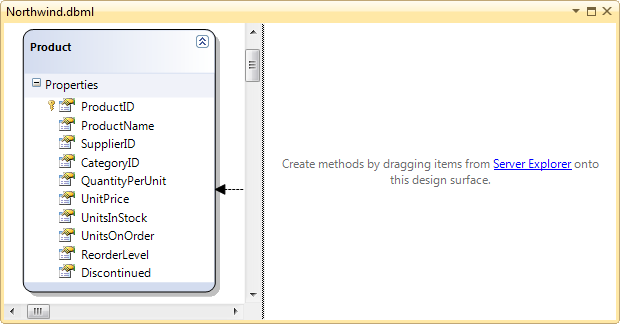
Where() query method is used to filter the items in the IQueryable<T> collection:
using (NorthwindDataContext database = new NorthwindDataContext()) { IQueryable<Product> source = database.Products; IQueryable<Product> results = source.Where(product => product.UnitPrice > 100); foreach (Product item in results) { Console.WriteLine("{0}: {1}", item.ProductName, item.UnitPrice); } }
This will prints:
Thüringer Rostbratwurst: 123.7900
Côte de Blaye: 263.5000
The above query will be translated to:
exec sp_executesql N'SELECT [t0].[ProductID], [t0].[ProductName], [t0].[SupplierID], [t0].[CategoryID], [t0].[QuantityPerUnit], [t0].[UnitPrice], [t0].[UnitsInStock], [t0].[UnitsOnOrder], [t0].[ReorderLevel], [t0].[Discontinued] FROM [dbo].[Products] AS [t0] WHERE [t0].[UnitPrice] > @p0',N'@p0 decimal(33,4)',@p0=100.0000
This can be traced by SQL Server Profiler.
The other overload of Where():
IQueryable<TSource> Where<TSource>( this IQueryable<TSource> source, Expression<Func<TSource, int, bool>> predicate)
is not supported in LINQ to SQL.
AND / OR
&& / || can be used in Where():
IQueryable<Product> results = source.Where( product => product.UnitPrice < 20 || product.UnitPrice > 90);
This is translated to:
exec sp_executesql N'SELECT [t0].[ProductID], [t0].[ProductName], [t0].[SupplierID], [t0].[CategoryID], [t0].[QuantityPerUnit], [t0].[UnitPrice], [t0].[UnitsInStock], [t0].[UnitsOnOrder], [t0].[ReorderLevel], [t0].[Discontinued] FROM [dbo].[Products] AS [t0] WHERE ([t0].[UnitPrice] < @p0) OR ([t0].[UnitPrice] > @p1)',N'@p0 decimal(33,4),@p1 decimal(33,4)',@p0=20.0000,@p1=90.0000
Or Where() can be invoked for multiple times:
IQueryable<Product> results = source.Where(product => product.UnitPrice < 20) .Where(product => product.ReorderLevel > 10);
This is translated to:
exec sp_executesql N'SELECT [t0].[ProductID], [t0].[ProductName], [t0].[SupplierID], [t0].[CategoryID], [t0].[QuantityPerUnit], [t0].[UnitPrice], [t0].[UnitsInStock], [t0].[UnitsOnOrder], [t0].[ReorderLevel], [t0].[Discontinued] FROM [dbo].[Products] AS [t0] WHERE ([t0].[ReorderLevel] > @p0) AND ([t0].[UnitPrice] < @p1)',N'@p0 int,@p1 decimal(33,4)',@p0=10,@p1=20.0000
LIKE
.NET API can be used for constructing query. Typically, when working with character data, string.StartsWith() can be used
IQueryable<Product> results = source.Where(product => product.ProductName.StartsWith("B"));
string.StartsWith(“x”) is recognized and translated to LIKE N’x%’:
exec sp_executesql N'SELECT [t0].[ProductID], [t0].[ProductName], [t0].[SupplierID], [t0].[CategoryID], [t0].[QuantityPerUnit], [t0].[UnitPrice], [t0].[UnitsInStock], [t0].[UnitsOnOrder], [t0].[ReorderLevel], [t0].[Discontinued] FROM [dbo].[Products] AS [t0] WHERE [t0].[ProductName] LIKE @p0',N'@p0 nvarchar(4000)',@p0=N'B%'
The same for string.EndsWith(“y”) and string.Contains(“z”). They are translated LIKE N’%y’ and LIKE N’%z%’.
Generally, SqlMethods.Like() can be used for LIKE operation:
IQueryable<Product> results = source.Where( product => SqlMethods.Like(product.ProductName, "%st%"));
It can be recognized and translated to LIKE.
For the detail of wildcards, please check MSDN.
IN
When IEnumerable<T>.Contains() is used:
IEnumerable<string> names = new string[] { "Chai", "Chang", "Tofu" }; IQueryable<Product> results = source.Where(product => names.Contains(product.ProductName));
it is translated to IN:
exec sp_executesql N'SELECT [t0].[ProductID], [t0].[ProductName], [t0].[SupplierID], [t0].[CategoryID], [t0].[QuantityPerUnit], [t0].[UnitPrice], [t0].[UnitsInStock], [t0].[UnitsOnOrder], [t0].[ReorderLevel], [t0].[Discontinued] FROM [dbo].[Products] AS [t0] WHERE [t0].[ProductName] IN (@p0, @p1, @p2)',N'@p0 nvarchar(4000),@p1 nvarchar(4000),@p2 nvarchar(4000)',@p0=N'Chai',@p1=N'Chang',@p2=N'Tofu'
IS / NOT / NULL
The following code:
IQueryable<Product> results = source.Where(product => product.CategoryID != null);
is translated to:
SELECT [t0].[ProductID], [t0].[ProductName], [t0].[SupplierID], [t0].[CategoryID], [t0].[QuantityPerUnit], [t0].[UnitPrice], [t0].[UnitsInStock], [t0].[UnitsOnOrder], [t0].[ReorderLevel], [t0].[Discontinued] FROM [dbo].[Products] AS [t0] WHERE [t0].[CategoryID] IS NOT NULL
The predicate “product.CategoryID != null” is not executed in CLR but translated to SQL and remotely executed in SQL Server.
Projection (SELECT, CASE)
If querying all fields is not necessary, Select() can be used to specify the fields:
using (NorthwindDataContext database = new NorthwindDataContext()) { IQueryable<Product> source = database.Products; var results = source.Where(product => product.UnitPrice > 100) .Select(product => new { product.ProductName, product.UnitPrice }); foreach (var item in results) { Console.WriteLine("{0}: {1}", item.ProductName, item.UnitPrice); } }
Here var must be used because anonymous type is created.
It is translated to:
exec sp_executesql N'SELECT [t0].[ProductName], [t0].[UnitPrice] FROM [dbo].[Products] AS [t0] WHERE [t0].[UnitPrice] > @p0',N'@p0 decimal(33,4)',@p0=100.0000
Only explicitly required fields (ProductName and UnitPrice) are queried.
Explicitly construct entity
In the above sample, constructing an object of anonymous type looks unnecessary. It should be Ok to use the Product type directly:
IQueryable<Product> results = source.Where(product => product.UnitPrice > 100) .Select(product => new Product() { ProductName = product.ProductName, UnitPrice = product.UnitPrice }); foreach (Product item in results) { Console.WriteLine("{0}: {1}", item.ProductName, item.UnitPrice); }
But this code throws an NotSupportedException at runtime:
Explicit construction of entity type 'Product' in query is not allowed.
Explicit construction of entity type is not allowed after .NET 3.5 Beta2. According to Microsoft, this is because:
This check was added because it was supposed to be there from the beginning and was missing. Constructing entity instances manually as a projection pollutes the cache with potentially malformed objects, leading to confused programmers and lots of bug reports for us. In addition, it is ambiguous whether projected entities should be in the cache or changed tracked at all. The usage pattern for entities is that they are created outside of queries and inserted into tables via the DataContext and then later retrieved via queries, never created by queries.
To explicitly construct entity, there are several ways to work around. One way is construct object of anonymous type, then use LINQ to Objects to construct entity:
IEnumerable<Product> results = source.Where(product => product.UnitPrice > 100) .Select(product => new { product.ProductName, product.UnitPrice }) .AsEnumerable() // Converts to IEnumerable<T> .Select(item => new Product() { ProductName = item.ProductName, UnitPrice = item.UnitPrice }); // Uses IEnumerable<T>.Select()
CASE
The following query:
var results = source.Where(product => product.ReorderLevel > 20) .Select(product => new { ProductName = product.ProductName, IsExpensive = product.UnitPrice < 10 });
is translated to CASE:
exec sp_executesql N'SELECT [t0].[ProductName], (CASE WHEN [t0].[UnitPrice] < @p1 THEN 1 WHEN NOT ([t0].[UnitPrice] < @p1) THEN 0 ELSE NULL END) AS [IsExpensive] FROM [dbo].[Products] AS [t0] WHERE [t0].[ReorderLevel] > @p0',N'@p0 int,@p1 decimal(33,4)',@p0=20,@p1=10.0000
Ordering (ORDER BY, ASC, DESC)
The query methods OrderBy(), OrderByDescending(), ThenBy(), ThenByDescending() work similarly with LINQ to Objects.
The following OrderBy(A).OrderBy(B):
var results = source.Where(product => product.ReorderLevel > 20) .OrderBy(product => product.ProductName) .OrderBy(product => product.UnitPrice) .Select(product => new { ProductName = product.ProductName, UnitPrice = product.UnitPrice });
is translated to ORDER BY B, A:
exec sp_executesql N'SELECT [t0].[ProductName], [t0].[UnitPrice] FROM [dbo].[Products] AS [t0] WHERE [t0].[ReorderLevel] > @p0 ORDER BY [t0].[UnitPrice], [t0].[ProductName]',N'@p0 int',@p0=20
While OrderBy(A).ThenBy(B):
var results = source.Where(product => product.ReorderLevel > 20) .OrderBy(product => product.ProductName) .ThenBy(product => product.UnitPrice) .Select(product => new { ProductName = product.ProductName, UnitPrice = product.UnitPrice });
is translated to ORDER BY A, B:
exec sp_executesql N'SELECT [t0].[ProductName], [t0].[UnitPrice] FROM [dbo].[Products] AS [t0] WHERE [t0].[ReorderLevel] > @p0 ORDER BY [t0].[ProductName], [t0].[UnitPrice]',N'@p0 int',@p0=20
Join (JOIN, INNER JOIN, OUTER JOIN, CROSS JOIN)
LINQ to SQL can implement all kinds of SQL join. But this is not easy enough. In the following samples, query methods and query expressions will be both provided for contrast.
Natural join
Natural JOIN is typically applied in one-to-one scenarios. But natural join is not supported by either SQL Server or LINQ to SQL. Natural join should be implemented via INNER JOIN.
The interesting thing is, there are some posts talking about SQL Server natural join, like this one from C# Corner, and this one from Microsoft VB team.
INNER JOIN
INNER JOIN is very typically applied one-to-many scenarios (One-to-one natural join can be considered as a special one-to-many scenario, where “many” consists of “one”.).
Take the Products table and Categories table as an example. This is the model of both tables, and the foreign key is mapped as an association:
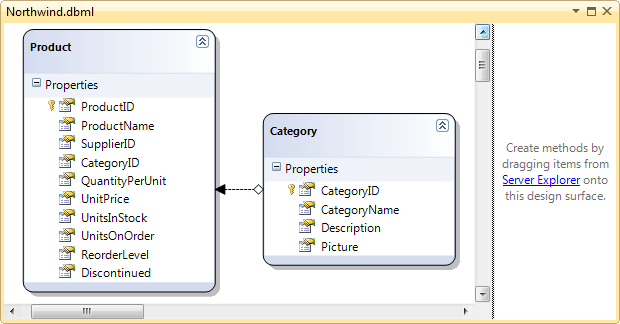
Similar with LINQ to Objects queries, INNER JOIN can be implemented by Join().
IQueryable<Product> outer = database.Products; IQueryable<Category> inner = database.Categories; var results = outer.Where(product => product.UnitPrice > 100) .Join( inner, product => product.CategoryID, category => category.CategoryID, (product, category) => new { ProductName = product.ProductName, UnitPrice = product.UnitPrice, CategoryName = category.CategoryName });
is translated into:
exec sp_executesql N'SELECT [t0].[ProductName], [t0].[UnitPrice], [t1].[CategoryName] FROM [dbo].[Products] AS [t0] INNER JOIN [dbo].[Categories] AS [t1] ON [t0].[CategoryID] = ([t1].[CategoryID]) WHERE [t0].[UnitPrice] > @p0',N'@p0 decimal(33,4)',@p0=100.0000
Here, in C#, Where() is before Join(). This is Ok for translating to SQL, where Join() should come before Where().
The above query can be implemented by query expression:
var results = from product in outer where product.UnitPrice > 100 join category in inner on product.CategoryID equals category.CategoryID select new { ProductName = product.ProductName, UnitPrice = product.UnitPrice, CategoryName = category.CategoryName };
which looks a little easier.
INNER JOIN can also be done by SelectMany():
IQueryable<Category> source = database.Categories; var results = source.Where(category => category.CategoryName == "Beverages") .SelectMany( category => category.Products, (category, product) => new { ProductName = product.ProductName, UnitPrice = product.UnitPrice, CategoryName = category.CategoryName });
This is translated to:
exec sp_executesql N'SELECT [t1].[ProductName], [t1].[UnitPrice], [t0].[CategoryName] FROM [dbo].[Categories] AS [t0], [dbo].[Products] AS [t1] WHERE ([t0].[CategoryName] = @p0) AND ([t1].[CategoryID] = [t0].[CategoryID])',N'@p0 nvarchar(4000)',@p0=N'Beverages'
OUTER JOIN
OUTER JOIN is also typically applied one-to-many scenarios. OUTER JOIN can be implemented by GroupJoin().
using (NorthwindDataContext database = new NorthwindDataContext()) { IQueryable<Product> outer = database.Products; IQueryable<Category> inner = database.Categories; var results = outer.Where(product => product.UnitPrice < 10) .OrderBy(product => product.ProductName) .GroupJoin( inner, product => product.CategoryID, category => category.CategoryID, (product, categories) => new { Product = product, Categories = categories }) .SelectMany( // Flattens the data after outer join. item => item.Categories.DefaultIfEmpty(), (item, category) => new { ProductName = item.Product.ProductName, CategoryName = category.CategoryName }); foreach (var item in results) { Console.WriteLine("{0} <- {1}", item.ProductName, item.CategoryName); } }
is translated to:
exec sp_executesql N'SELECT [t0].[ProductName], [t1].[CategoryName] AS [CategoryName] FROM [dbo].[Products] AS [t0] LEFT OUTER JOIN [dbo].[Categories] AS [t1] ON [t0].[CategoryID] = ([t1].[CategoryID]) WHERE [t0].[UnitPrice] < @p0 ORDER BY [t0].[ProductName]',N'@p0 decimal(33,4)',@p0=10.0000
and prints:
Filo Mix <- Grains/Cereals
Geitost <- Dairy Products
Guaraná Fantástica <- Beverages
Jack's New England Clam Chowder <- Seafood
Konbu <- Seafood
Rhönbräu Klosterbier <- Beverages
Rogede sild <- Seafood
Teatime Chocolate Biscuits <- Confections
Tourtière <- Meat/Poultry
Tunnbröd <- Grains/Cereals
Zaanse koeken <- Confections
This looks a little tough. Query expression is a little easier:
var results = from product in outer where product.UnitPrice < 10 orderby product.ProductName join category in inner on product.CategoryID equals category.CategoryID into categories from item in categories.DefaultIfEmpty() select new { ProductName = product.ProductName, CategoryName = item.CategoryName };
Notice the second from. 2 “from”s will be compiled into SelectMany().
For consistency, it is recommended to always use query methods.
One thing need to pay attention is, do not forget the DefaultIfEmpty() invocation, because one Product object is OUTER JOINed with a group of Category objects, and that group might be null. Without DefaultIfEmpty(), OUTER JOIN cannot be applied, and the query will be translated into INNER JOIN.
Association (OUTER JOIN)
A simpler implementation of OUTER JOIN is using the table association. For example,
IQueryable<Product> source = database.Products; var results = source.Where(product => product.UnitPrice < 10) .OrderBy(product => product.ProductName) .Select(product => new { ProductName = product.ProductName, CategoryName = product.Category.CategoryName });
This is translated to the same SQL above.
Here is another sample using table association to implement OUTER JOIN:
IQueryable<Product> source = database.Products; var results = source.Where(product => product.Category.CategoryName == "Beverages") .Select(product => new { ProductName = product.ProductName, UnitPrice = product.UnitPrice });
It is translated to:
exec sp_executesql N'SELECT [t0].[ProductName], [t0].[UnitPrice] FROM [dbo].[Products] AS [t0] LEFT OUTER JOIN [dbo].[Categories] AS [t1] ON [t1].[CategoryID] = [t0].[CategoryID] WHERE [t1].[CategoryName] = @p0',N'@p0 nvarchar(4000)',@p0=N'Beverages'
CROSS JOIN
A typical usage of CROSS JOIN is in many-to-many scenarios. Many-to-many scenarios usually involves 3 table: 2 tables are associated related through a relationship table. For example, below Employees table and Territories table’s relationship are represented by the EmployeeTerritories relationship table:
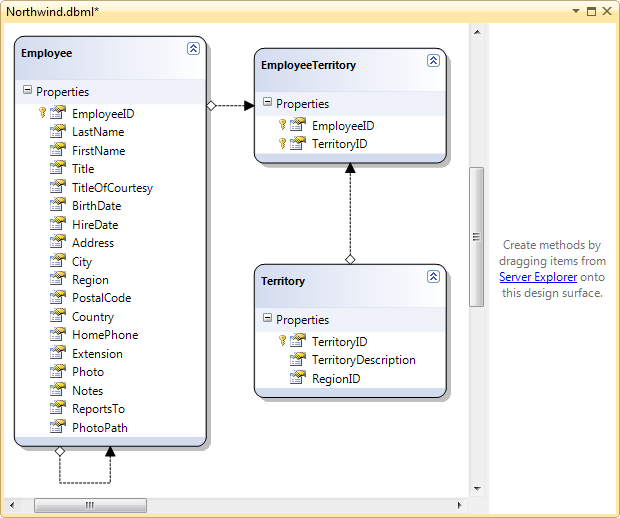
CROSS JOIN can be implemented by SelectMany(). The following query:
IQueryable<Category> source = database.Employees; var results = source.SelectMany( employee => employee.EmployeeTerritories, (employee, employeeTerritory) => new { FirstName = employee.FirstName, LastName = employee.LastName, TerritoryDescription = employeeTerritory.Territory.TerritoryDescription });
is equal to:
var results = from employee in source from territory in employee.EmployeeTerritories select new { FirstName = employee.FirstName, LastName = employee.LastName, TerritoryDescription = territory.Territory.TerritoryDescription };
because, as fore mentioned, 2 “from”s will be compiled into SelectMany().
So it is translated to:
SELECT [t0].[FirstName], [t0].[LastName], [t2].[TerritoryDescription] FROM [dbo].[Employees] AS [t0] CROSS JOIN [dbo].[EmployeeTerritories] AS [t1] INNER JOIN [dbo].[Territories] AS [t2] ON [t2].[TerritoryID] = [t1].[TerritoryID] WHERE [t1].[EmployeeID] = [t0].[EmployeeID]
Firstly Employees table CROSS JOINs the relationship table EmployeeTerritories, then INNER JOINs the Territories.
Self JOIN
Self JOIN is somehow more interesting. Take a look at the above Employees table:
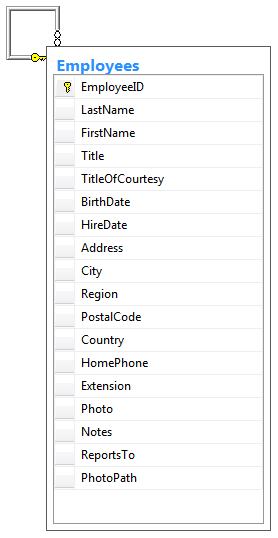
There is a foreign key within this table, from EmployeeID to ReportTo:
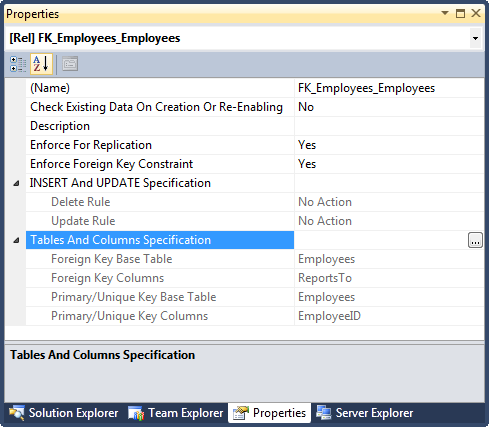
This is the model of Employee table:

The above foreign key is mapped as an association:

So a self JOIN can be performed on Employees table and Employees table through this foreign key:
IQueryable<Employee> source = database.Employees; var results = source.SelectMany( manager => manager.Employees, (manager, employee) => new { Manager = manager.FirstName + " " + manager.LastName, Employee = employee.FirstName + " " + employee.LastName });
This is translated to:
exec sp_executesql N'SELECT ([t0].[FirstName] + @p0) + [t0].[LastName] AS [Manager], ([t1].[FirstName] + @p1) + [t1].[LastName] AS [Employee] FROM [dbo].[Employees] AS [t0], [dbo].[Employees] AS [t1] WHERE [t1].[ReportsTo] = [t0].[EmployeeID]',N'@p0 nvarchar(4000),@p1 nvarchar(4000)',@p0=N' ',@p1=N' '
Grouping and aggregation (GROUP BY / aggregate functions / HAVING )
In SQL, GROUP BY works with aggregation. However, the concept of grouping is different in LINQ to SQL, and aggregating is optional. LINQ to SQL grouping just reorganize items into IGrouping<Tkey, TElement>s, which is the same as LINQ to Objects grouping:
namespace System.Linq { public interface IGrouping<out TKey, out TElement> : IEnumerable<TElement>, IEnumerable { TKey Key { get; } } }
Grouping can be implemented by GroupBy():
using (NorthwindDataContext database = new NorthwindDataContext()) { IQueryable<Product> source = database.Products; IQueryable<IGrouping<string, string>> groups = source.GroupBy( product => product.ProductName.Substring(0, 1), // For TKey of IGrouping. product => product.ProductName); // For TElement of IGrouping. foreach (IGrouping<string, string> group in groups) { Console.Write("Group {0}: ", group.Key); foreach (string productName in group) // Iterates items in the group. { Console.Write("[{0}] ", productName); } Console.WriteLine(); } }
This prints:
Group A: [Alice Mutton] [Aniseed Syrup]
Group B: [Boston Crab Meat]
Group C: [Camembert Pierrot] [Carnarvon Tigers] [Chai] [Chang] [Chartreuse verte] [Chef Anton's Cajun Seasoning] [Chef Anton's Gumbo Mix] [Chocolade] [Côte de Blaye]
Group E: [Escargots de Bourgogne]
Group F: [Filo Mix] [Flotemysost]
Group G: [Geitost] [Genen Shouyu] [Gnocchi di nonna Alice] [Gorgonzola Telino] [Grandma's Boysenberry Spread] [Gravad lax] [Guaraná Fantástica] [Gudbrandsdalsost] [Gula Malacca] [Gumbär Gummibärchen] [Gustaf's Knäckebröd]
Group I: [Ikura] [Inlagd Sill] [Ipoh Coffee]
Group J: [Jack's New England Clam Chowder]
Group K: [Konbu]
Group L: [Lakkalikööri] [Laughing Lumberjack Lager] [Longlife Tofu] [Louisiana Fiery Hot Pepper Sauce] [Louisiana Hot Spiced Okra]
Group M: [Manjimup Dried Apples] [Mascarpone Fabioli] [Maxilaku] [Mishi Kobe Niku] [Mozzarella di Giovanni]
Group N: [Nord-Ost Matjeshering] [Northwoods Cranberry Sauce] [NuNuCa Nuß-Nougat-Creme]
Group O: [Original Frankfurter grüne Soße] [Outback Lager]
Group P: [Pâté chinois] [Pavlova] [Perth Pasties]
Group Q: [Queso Cabrales] [Queso Manchego La Pastora]
Group R: [Raclette Courdavault] [Ravioli Angelo] [Rhönbräu Klosterbier] [Röd Kaviar] [Rogede sild] [Rössle Sauerkraut]
Group S: [Sasquatch Ale] [Schoggi Schokolade] [Scottish Longbreads] [Singaporean Hokkien Fried Mee] [Sir Rodney's Marmalade] [Sir Rodney's Scones] [Sirop d'érable] [Spegesild] [Steeleye Stout]
Group T: [Tarte au sucre] [Teatime Chocolate Biscuits] [Thüringer Rostbratwurst] [Tofu] [Tourtière] [Tunnbröd]
Group U: [Uncle Bob's Organic Dried Pears]
Group V: [Valkoinen suklaa] [Vegie-spread]
Group W: [Wimmers gute Semmelknödel]
Group Z: [Zaanse koeken]
This query produces a simple grouping in LINQ to SQL. Obviously, there is no aggregating, so there is no way to translate the query into GROUP BY. Here LINQ to SQL does the 2 things:
- queries all keys (CategoryIDs), each key stands for one group;
- for each key (CategoryID), queries the items Products table, and put the queried items into an IGrouping<Tkey, TElement>.
So the final query result is a collection of groups.
This is translated to the following tens of SQL queries:
-- Queries all keys, each key stands for a group exec sp_executesql N'SELECT [t1].[value] AS [Key] FROM ( SELECT SUBSTRING([t0].[ProductName], @p0 + 1, @p1) AS [value] FROM [dbo].[Products] AS [t0] ) AS [t1] GROUP BY [t1].[value]',N'@p0 int,@p1 int',@p0=0,@p1=1 -- Queries the items for the first key 'A'. exec sp_executesql N'SELECT [t0].[ProductName] FROM [dbo].[Products] AS [t0] WHERE ((@x1 IS NULL) AND (SUBSTRING([t0].[ProductName], @p0 + 1, @p1) IS NULL)) OR ((@x1 IS NOT NULL) AND (SUBSTRING([t0].[ProductName], @p0 + 1, @p1) IS NOT NULL) AND (@x1 = SUBSTRING([t0].[ProductName], @p0 + 1, @p1)))',N'@p0 int,@p1 int,@x1 nvarchar(4000)',@p0=0,@p1=1,@x1=N'A' -- Queries the items for the second key 'B'. exec sp_executesql N'SELECT [t0].[ProductName] FROM [dbo].[Products] AS [t0] WHERE ((@x1 IS NULL) AND (SUBSTRING([t0].[ProductName], @p0 + 1, @p1) IS NULL)) OR ((@x1 IS NOT NULL) AND (SUBSTRING([t0].[ProductName], @p0 + 1, @p1) IS NOT NULL) AND (@x1 = SUBSTRING([t0].[ProductName], @p0 + 1, @p1)))',N'@p0 int,@p1 int,@x1 nvarchar(4000)',@p0=0,@p1=1,@x1=N'B' -- ... -- Queries the items for the last key 'Z'. exec sp_executesql N'SELECT [t0].[ProductName] FROM [dbo].[Products] AS [t0] WHERE ((@x1 IS NULL) AND (SUBSTRING([t0].[ProductName], @p0 + 1, @p1) IS NULL)) OR ((@x1 IS NOT NULL) AND (SUBSTRING([t0].[ProductName], @p0 + 1, @p1) IS NOT NULL) AND (@x1 = SUBSTRING([t0].[ProductName], @p0 + 1, @p1)))',N'@p0 int,@p1 int,@x1 nvarchar(4000)',@p0=0,@p1=1,@x1=N'Z'
GROUP BY / aggregate functions
When aggregate function is provided in grouping, it is able to translate the query to GROUP BY. Take COUNT as example:
using (NorthwindDataContext database = new NorthwindDataContext()) { IQueryable<Product> source = database.Products; var groups = source.GroupBy( // The key of each group. product => product.CategoryID, // Count() aggregates items of each group into one single value. (key, products) => new { Key = key, Count = products.Count() }); foreach (var group in groups) { Console.WriteLine("Category {0}: {1} Products", group.Key, group.Count); } }
is translated to:
SELECT COUNT(*) AS [Count], [t0].[CategoryID] AS [Key] FROM [dbo].[Products] AS [t0] GROUP BY [t0].[CategoryID]
and prints:
Category 1: 12 Products
Category 2: 12 Products
Category 3: 13 Products
Category 4: 10 Products
Category 5: 7 Products
Category 6: 6 Products
Category 7: 5 Products
Category 8: 12 Products
HAVING
When filtering a GROUP BY:
var groups = source.GroupBy( product => product.CategoryID, (key, products) => new { Key = key, Count = products.Count() }) .Where(group => group.Count > 10);
It is translated to a WHERE query, which wraps the GROUP BY query inside:
exec sp_executesql N'SELECT [t1].[CategoryID] AS [Key], [t1].[value] AS [Count] FROM ( SELECT COUNT(*) AS [value], [t0].[CategoryID] FROM [dbo].[Products] AS [t0] GROUP BY [t0].[CategoryID] ) AS [t1] WHERE [t1].[value] > @p0',N'@p0 int',@p0=10
which works the same as HAVING:
SELECT COUNT(*) AS value, CategoryID FROM Products AS t0 GROUP BY CategoryID HAVING (COUNT(*) > 10)
There are a lot of interesting posts on the Internet talking about translating LINQ to SQL queries into HAVING, like this one from Microsoft VB team, this one, this one, and this one, etc. Actually, none of the queries they provided is translated to HAVING.
Set (DISTINCT / UNION / EXISTS)
In the 5 set query method of IQueryable<T>, Zip() is not supported in LINQ to SQL. The other 4 works.
DISTINCT
DISTINCT can be implemented by invoking Distinct() query method. For example:
IQueryable<Product> source = database.Products; IQueryable<int?> results = source.Where(product => product.UnitPrice > 100) .Select(product => product.CategoryID) .Distinct();
is translated to:
exec sp_executesql N'SELECT DISTINCT [t0].[CategoryID] FROM [dbo].[Products] AS [t0] WHERE [t0].[UnitPrice] > @p0',N'@p0 decimal(33,4)',@p0=100.0000
UNION
UNION can be implemented by Union(). Please notice UNION includes a DISTINCT calculation in SQL and so that the same in LINQ to SQL. For example:
IQueryable<Supplier> source = database.Suppliers; IQueryable<Order> source2 = database.Orders; Console.WriteLine(source.Count()); // 29 Console.WriteLine(source2.Count()); // 830 IQueryable<string> results = source.Select(supplier => supplier.City) .Union(source2.Select(order => order.ShipCity)); Console.WriteLine(results.Count()); // 94
is translated to:
SELECT COUNT(*) AS [value] FROM [dbo].[Suppliers] AS [t0] SELECT COUNT(*) AS [value] FROM [dbo].[Orders] AS [t0] SELECT COUNT(*) AS [value] FROM ( SELECT [t0].[City] FROM [dbo].[Suppliers] AS [t0] UNION SELECT [t1].[ShipCity] FROM [dbo].[Orders] AS [t1] ) AS [t2]
EXISTS
EXISTS can be implemented by Intersect().
IQueryable<Customer> source = database.Customers; IQueryable<Supplier> source2 = database.Suppliers; IQueryable<string> results = source.Select(customer => customer.CompanyName) .Intersect(source2.Select( supplier => supplier.CompanyName));
is translated to:
SELECT DISTINCT [t0].[CompanyName] FROM [dbo].[Customers] AS [t0] WHERE EXISTS( SELECT NULL AS [EMPTY] FROM [dbo].[Suppliers] AS [t1] WHERE [t0].[CompanyName] = [t1].[CompanyName] )
NOT EXISTS
Except() is opposite of Intersect().
IQueryable<string> results = source.Select(customer => customer.CompanyName) .Except(source2.Select( supplier => supplier.CompanyName));
is translated to:
SELECT DISTINCT [t0].[CompanyName] FROM [dbo].[Customers] AS [t0] WHERE NOT (EXISTS( SELECT NULL AS [EMPTY] FROM [dbo].[Suppliers] AS [t1] WHERE [t0].[CompanyName] = [t1].[CompanyName] ))
Partitioning (TOP / ROW_NUMBER() / BETWEEN AND)
The partitioning is very simple via LINQ to SQL.
TOP
The following code queries the most expensive 10 products:
IQueryable<Product> source = database.Products; var results = source.Select(product => new { ProductName = product.ProductName, UnitPrice = product.UnitPrice }) .OrderByDescending(item => item.UnitPrice) .Take(10);
And it is translated to:
SELECT TOP (10) [t0].[ProductName], [t0].[UnitPrice] FROM [dbo].[Products] AS [t0] ORDER BY [t0].[UnitPrice] DESC
ROW_NUMBER()
The Skip() is implemented by generating an extra ROW_NUMBER field. The following query:
var results = source.Select(product => new { ProductName = product.ProductName, UnitPrice = product.UnitPrice }) .OrderByDescending(item => item.UnitPrice) .Skip(10);
is translated to:
exec sp_executesql N'SELECT [t1].[ProductName], [t1].[UnitPrice] FROM ( SELECT ROW_NUMBER() OVER (ORDER BY [t0].[UnitPrice] DESC) AS [ROW_NUMBER], [t0].[ProductName], [t0].[UnitPrice] FROM [dbo].[Products] AS [t0] ) AS [t1] WHERE [t1].[ROW_NUMBER] > @p0 ORDER BY [t1].[ROW_NUMBER]',N'@p0 int',@p0=10
BETWEEN AND
Skip().Take() immediately implements pagination:
var results = source.Select(product => new { ProductName = product.ProductName, UnitPrice = product.UnitPrice }) .OrderByDescending(item => item.UnitPrice) .Skip(20).Take(10);
It is translated to:
exec sp_executesql N'SELECT [t1].[ProductName], [t1].[UnitPrice] FROM ( SELECT ROW_NUMBER() OVER (ORDER BY [t0].[UnitPrice] DESC) AS [ROW_NUMBER], [t0].[ProductName], [t0].[UnitPrice] FROM [dbo].[Products] AS [t0] ) AS [t1] WHERE [t1].[ROW_NUMBER] BETWEEN @p0 + 1 AND @p0 + @p1 ORDER BY [t1].[ROW_NUMBER]',N'@p0 int,@p1 int',@p0=20,@p1=10
A Page() method is implemented in another post: C# Coding Guidelines (6) Documentation.
Concatenation (UNION ALL)
There is only one concatenation query method, Concat().
UNION ALL
The UNION ALL can be implemented by Concate().
IQueryable<Customer> source = database.Customers; IQueryable<Supplier> source2 = database.Suppliers; IQueryable<string> results = source.Select(customer => customer.CompanyName) .Concat(source2.Select( supplier => supplier.CompanyName));
is translated to:
SELECT [t2].[CompanyName] FROM ( SELECT [t0].[CompanyName] FROM [dbo].[Customers] AS [t0] UNION ALL SELECT [t1].[CompanyName] FROM [dbo].[Suppliers] AS [t1] ) AS [t2]
Qualifiers (CASE / EXISTS)
The qualifiers are all translated to CASE and EXISTS.
CASE / EXISTS
This is an All() example:
IQueryable<Product> source = database.Products; bool result = source.All(product => product.UnitPrice < 300);
It is translated to:
exec sp_executesql N'SELECT (CASE WHEN NOT (EXISTS( SELECT NULL AS [EMPTY] FROM [dbo].[Products] AS [t1] WHERE ( (CASE WHEN [t1].[UnitPrice] < @p0 THEN 1 ELSE 0 END)) = 0 )) THEN 1 WHEN NOT NOT (EXISTS( SELECT NULL AS [EMPTY] FROM [dbo].[Products] AS [t1] WHERE ( (CASE WHEN [t1].[UnitPrice] < @p0 THEN 1 ELSE 0 END)) = 0 )) THEN 0 ELSE NULL END) AS [value]',N'@p0 decimal(33,4)',@p0=300.0000
This is an Any() example:
bool result = source.Any(product => product.UnitPrice < 300);
And this one is translated to:
exec sp_executesql N'SELECT (CASE WHEN EXISTS( SELECT NULL AS [EMPTY] FROM [dbo].[Products] AS [t0] WHERE [t0].[UnitPrice] < @p0 ) THEN 1 ELSE 0 END) AS [value]',N'@p0 decimal(33,4)',@p0=300.0000
The other overload of Any()
bool result = source.Any();
is translated to:
SELECT (CASE WHEN EXISTS( SELECT NULL AS [EMPTY] FROM [dbo].[Products] AS [t0] ) THEN 1 ELSE 0 END) AS [value]
And Contains():
bool result = source.Select(product=>product.ProductID).Contains(1);
is translated to:
exec sp_executesql N'SELECT (CASE WHEN EXISTS( SELECT NULL AS [EMPTY] FROM [dbo].[Products] AS [t0] WHERE [t0].[ProductID] = @p0 ) THEN 1 ELSE 0 END) AS [value]',N'@p0 int',@p0=1
Other queries
The other queries, OfType() and Cast() are not covered in detail. Because they are more like LINQ to Objects calculation when translated to SQL.
